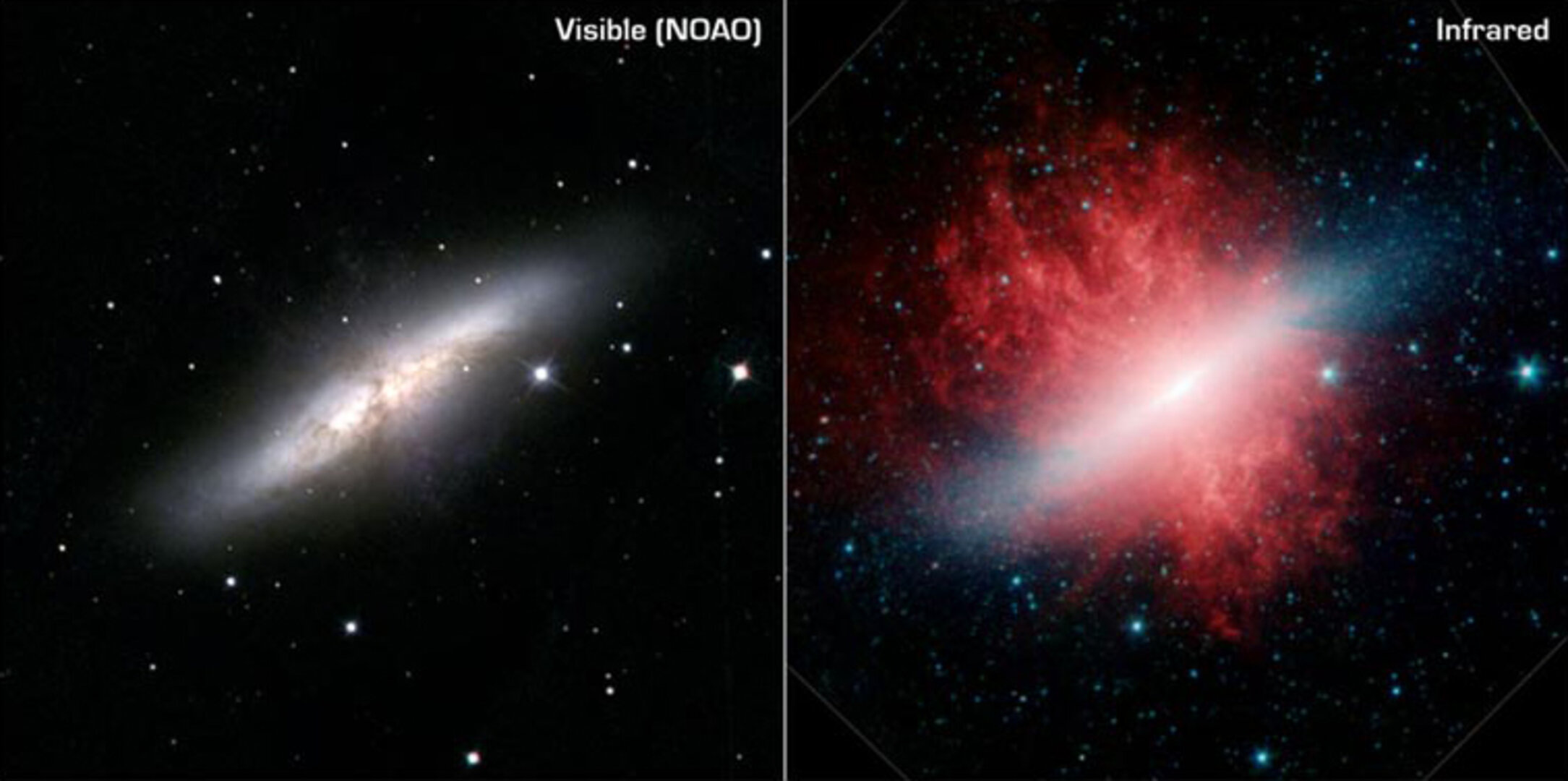More about the infrared
Observations in the infrared have revolutionised astronomy, revealing previously hidden aspects of the Universe that have changed our perception of the world around us. The Universe seen in the infrared has proved amazingly rich and diverse. It has given us keys to unlock the chemistry of the Universe, to explain how stars are born and to establish the origin of galaxies.
The use of infrared technology in astronomy is now well advanced and the infrared revolution is in full swing. But the golden age of infrared astronomy has just begun.
The cool Universe is best studied in the infrared.
Astronomers have used several different properties of infrared light to reveal more about the Universe. Although our eyes cannot see infrared radiation we can sense it — as radiant heat. Infrared radiation 'is' heat, and all objects, even the coldest ones, an ice cube for example, emit a certain amount of heat.
In fact, celestial objects with surface temperatures of about 2000°C — cold compared to the Sun which has a surface temperature of about 5500°C — radiate most of their energy at infrared wavelengths. The Universe is full of cool objects, including ageing stars, planets and dust, none of which generally shine brightly in the optical part of the spectrum and could not be observed directly until sensitive infrared detectors came along. The cool Universe is best studied in the infrared.
Longer-wavelength infrared radiation passes through unhindered and dust is therefore transparent to it.
Dust is the bane of the optical astronomer's life, blocking the view of many interesting objects. The Universe is full of dust, microscopic particles of varied composition — carbon, silicon, water ice, minerals, frozen carbon monoxide, organic compounds, silicates — the list is almost endless.
The particles can be hard or soft and come in many different shapes, but their size is usually less than 1 micron (one thousandth of a millimetre). The wavelength of visible light is much the same size as many dust particles, so it is easily blocked (scattered) by the dust, whereas longer-wavelength infrared radiation passes through unhindered and dust is therefore transparent to it. And in the far-infrared, we see the 'glow' from dust itself.
The chemical make-up of dust clouds and other interesting regions can be probed by looking at the spectra of their molecules, often only in the infrared. The reason is that most atoms and molecules emit radiation which has energy corresponding to the infrared range (emitted during rotation and vibration). Besides, infrared radiation is typical of cooler regions, for instance dust clouds, where more complex compounds such as organic molecules are often found. Infrared astronomy has made many interesting discoveries related to these more complex molecules in space.
In the far-infrared, we see the 'glow' from dust itself.
Infrared radiation can help us learn much more about the young‚ distant Universe. The Universe has been expanding since the Big Bang — the event that formed it. There were no stars or galaxies to begin with, but they started to form relatively early. We now know that at half the Universe's present age, star formation was much more vigorous than it is today and that in the very beginning it was zero. So the rate of star formation rate varies in cosmic time.
ESA's Herschel mission, which launched on 14 May 2009, explored further into the far-infrared than ever before, studying otherwise invisible dusty and cold regions of the cosmos, both near and far. It was designed to observe infrared-dominated galaxies – which are mostly star-burst galaxies where stars from a thousand times faster than in the Milky Way at present, enabling us to observe these galaxies through the cosmic epochs when most of the stars that ever existed in the Universe formed.
When Herschel launched, it carried the largest telescope ever flown in space, with a main mirror measuring 3.5 m across. This was more than four times larger than any previous infrared space telescope and almost one and a half times larger than that of the Hubble Space Telescope.
It was the first space observatory to extend the observations from the far-infrared into submillimetre wavelengths and bridge the two. By tapping these unexploited wavelengths, Herschel could see phenomena beyond the reach of other observatories, and study others at a level of detail that had not been captured before.
The James Webb Space Telescope (Webb) – an international partnership between NASA, ESA and the Canadian Space Agency (CSA) – is the next great space science observatory, designed to answer outstanding questions about the Universe and to make breakthrough discoveries in all fields of astronomy.
Its scientific instruments cover a wavelength range from about 0.6 μm to 28 μm (visible to mid-infrared light).
Launched on 25 December 2021, it is already helping us to see farther into our origins: from the formation of stars and planets, to the birth of the first galaxies in the early Universe.












